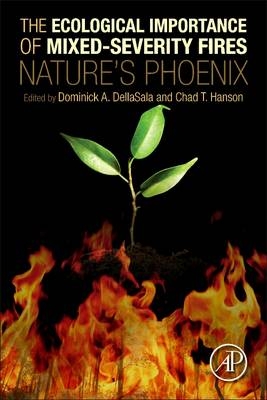
The Ecological Importance of Mixed-Severity Fires
Elsevier Science Publishing Co Inc (Verlag)
978-0-12-802749-3 (ISBN)
- Titel erscheint in neuer Auflage
- Artikel merken
While much of the current forest management in fire-adapted ecosystems, especially forests, is focused on fire prevention and suppression, little has been reported on the ecological role of fire, and nothing has been presented on the importance of high-severity fire with regards to the maintenance of native biodiversity and fire-dependent ecosystems and species.
This text fills that void, providing a comprehensive reference for documenting and synthesizing fire's ecological role.
Dominick DellaSala, Ph. D, is Chief Scientist of Wild Heritage, a project of the Earth Island Institute, and former President of the Society for Conservation Biology, North America. He is an internationally renowned scholar of over 200 publications on forest ecology, endangered species, conservation biology, and climate change. Dominick has given keynote talks ranging from academic conferences to the United Nations Earth Summit. He has been featured in hundreds of news stories and documentaries, testified in the US congress numerous times, and received conservation leadership and book writing awards. He is on the editorial board of Elsevier’s Earth Systems and Environmental Sciences, co-chief editor of Elsevier’s Encyclopedia of the Anthropocene, The World’s Biomes, and Encyclopedia of Conservation; Co-editor the Ecological Importance of Mixed Severity Fires: Nature’s Phoenix (Elsevier), editor and author of the award winning Temperate and Boreal Rainforests of the World: Ecology and Conservation; and subject editor of several scientific journals. He is driven by a passion to save life on Earth for his daughters, grandkids, and future generations. Dr. Chad Hanson is a research ecologist and the director of the John Muir Project of Earth Island Institute, located in Big Bear City, California. He has a Ph.D. in ecology from the University of California at Davis, with a research focus on fire ecology in conifer forest ecosystems, and he is the author of the 2021 book, “Smokescreen: Debunking Wildfire Myths to Save Our Forests and Our Climate, as well as the co-editor and co-author of the 2015 book, “The Ecological Importance of Mixed-Severity Fires: Nature’s Phoenix (Elsevier, Inc.). Research by Chad covers topics such as: natural post-fire forest regrowth and carbon sequestration; carbon flux in wildland fires; current forest fire patterns and trends; fire history; habitat selection of rare wildlife species associated with habitat created by high-intensity fire; and adverse impacts to wildlife caused by logging.
Section I: Biodiversity of Mixed- and High-Severity Fires 1. Setting the Stage for Mixed- and High-Severity Fires 2. Ecological and Biodiversity Benefits of Mega-Fires 3. Using Bird Ecology to Learn about the Benefits of Severe Fire 4. Mammal Habitat Selection in Mixed- and High-Severity Fires 5. Stream-Riparian Ecosystems of Mixed- and High-Severity Fires 6. Bark Beetles and Mixed- and High-Severity Fires in Rocky Mountain Subalpine Forests
Section 2: Global Perspectives on Mixed- and High-Severity Fires 7. High-Severity Fire in Chaparral: Cognitive Dissonance in the Shrublands 8. Regional Case Studies of Mixed-Severity Fires: South-East Australia, Sub-Saharan Africa, Central Europe, and Boreal Canada 9. Climate Change and Mixed- and High-Severity Fires: Uncertainties, Shifting Baselines, and Fire Management 10. Carbon Dynamics of Mixed- and High-Severity Wildfires: Pyrogenic CO2 Emissions, Post-fire Carbon Balance, and Succession
Section 3: Managing Mixed- and High-Severity Fires 11. In the Aftermath of Mixed- and High-Severity Fire: Logging and Related Actions Degrade Mixed and High-Severity Burn Areas 12. The Rising Costs of Wildfire Suppression and the Case for Ecological Fire Use 13. Flight of the Phoenix: Coexisting with Mixed-Severity Fires
| Sprache | englisch |
|---|---|
| Maße | 152 x 229 mm |
| Gewicht | 700 g |
| Themenwelt | Naturwissenschaften ► Biologie ► Ökologie / Naturschutz |
| ISBN-10 | 0-12-802749-5 / 0128027495 |
| ISBN-13 | 978-0-12-802749-3 / 9780128027493 |
| Zustand | Neuware |
| Haben Sie eine Frage zum Produkt? |
aus dem Bereich



